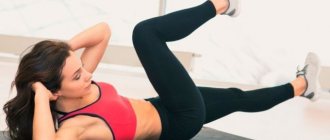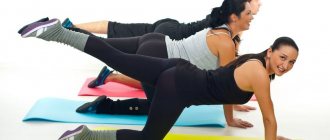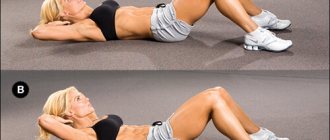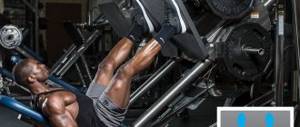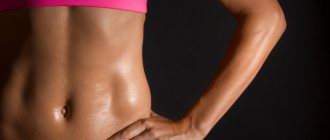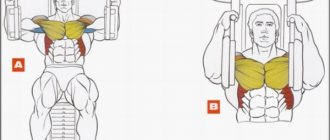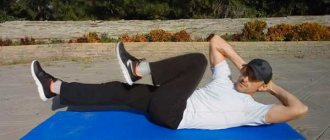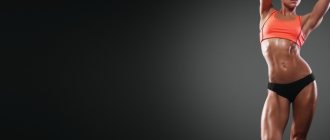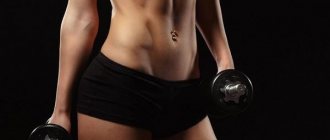Exercises for the abs. Top ten.
Why these exercises?
And why are there only ten of them? I learned about the effectiveness of these exercises for the abdominal muscles from my own practical experience of training and working as a trainer. It is these abdominal exercises that have proven highly effective in dozens of training programs for completely different people. My clients and I used these exercises to pump up powerful abs when bulking and to effectively lose weight in weight loss programs. Of course, when bulking up, we used additional weight on the head or hooked it to the legs. And in weight loss programs, we pumped up the abs with supersets, trisets and circuit training. But more on this in a separate article about training the abdominal muscles. It will also present other equally effective exercises.
https://www.youtube.com/watch?v=videoseries
Now about the exercises and how to use them. Try to carefully read the descriptions of exercise techniques so as not to lose effectiveness!
And you don't need to use all these exercises at once. It is enough to choose 2-3 and perform them according to the prescribed scheme of approaches and repetitions 3-4 times a week. Better every other day.
The effectiveness of the abdominal fold exercise
The fold or book, as it is also called, looks like double twists. The athlete reaches with straight arms towards his legs, and the buttocks become the main point of support. At the final moment, the body seems to form the letter V.
Many beginners consider regular crunches to be the best load option for training the abs. But these exercises make only the upper part of the abdominal muscles strong. Whereas the fold is universal. It helps tidy up the lower abdomen, which is more difficult to “finish off” with different variations of crunches.
The fold can immediately replace a set of abdominal exercises. With it, you will be able to abandon the combination of twisting and leg raises while hanging or lying down. This type of load is suitable for reducing the volume of the waist, and not just getting the coveted cubes. To burn midsection fat, abdominal training should be complemented by aerobic exercise. A prerequisite for losing weight in the waist area is a review of the nutrition system, switching to calorie counting while maintaining a deficit.
When working in the book, both the oblique and rectus abdominis muscles, along with its lower part, and the hip flexors are involved. The quadriceps muscles of the thigh are also involved in the movements. Therefore, the fold generally has a positive effect on the condition of the figure; if you regularly include it in the training program, you can notice changes within a couple of weeks. The exercise develops coordination of movements well. You can perform it lying on a mat or on a bench.
Despite its apparent simplicity, the fold is not so easy for beginners to master. Therefore, it is best to study the technique using preparatory or lead-in exercises. They will strengthen your muscles and develop body flexibility, making it comfortable to train your abs.
Benefits and disadvantages of exercise
The book exercise is mistakenly perceived as a movement from school physical education. This is one of the most effective exercises for the abdomen, which immediately engages the upper and lower abs, and is also performed in any environment (gym, home, or even an office chair).
READ MORE: Exercises with weights at home - 4 options with execution technique
There are no particular disadvantages to the exercise. The only possible disadvantages are incorrect technique and the inability to focus the load on the abdominal muscles (in this case, the legs take most of the load). Also, when performing ab movements on the floor, you need to be careful not to lean your body too far back. This will lead to increased tension on the lower back and reduce the load on the abs.
Pros and cons of the fold exercise
The main benefits of the abdominal tuck exercise:
- Works the entire abdominal area.
- It has several different execution techniques and difficulty options for athletes with different levels of training.
- Can be performed anywhere and does not require additional equipment.
- Prevents the appearance of inguinal and umbilical hernias.
- Normalizes posture by increasing the tone of the core muscles.
There are only two disadvantages - the complexity of execution (applies to some options) and the requirement to perfectly follow the technique. Without mastering it, the efficiency of movement will significantly decrease.
Lying crunches
Among all other abdominal exercises, this is the most common and effective. But provided that you do it correctly!
Lying crunches. Start.
Execution: lie on the mat, hands behind your head, legs bent at the knees.
It is necessary to take in air and stretch the chest. Then, as you exhale, lower your chest and lift your body slightly, lifting your back off the floor.
The most important thing is that the length of your abdominal muscles should change when performing the exercise. When twisting, they should shorten and contract as much as possible, and when returning back, they should lengthen and stretch. Do not try to lift your body too high when doing crunches. This is not required.
Pay attention to the position of your head and hands. You should not pull your head with your hands! The head rests freely on the palms and rises only slightly along with the body. Look up. Keep your elbows out to the sides at all times.
Crunches are usually performed at a slow pace with full amplitude - 3 sets of 12-25 repetitions.
Most likely, this abdominal exercise will not be suitable for most women, since it must be performed while hanging on a horizontal bar. This requires strong hands. But if ladies still dare to do it, I recommend using special gloves so as not to get calluses on the palms.
Bent leg raises on the horizontal bar. Start.
Execution: you need to hang on the horizontal bar so that your feet do not touch the floor. The abdominal muscles should be relaxed and stretched.
As you exhale, vigorously pull your knees toward your chest while bending your knees. Stay in this position for a moment, feeling the tension and contraction of your abdominal muscles. Then slowly, while inhaling, return your legs to their original position. Perform leg raises continuously, without long pauses between repetitions.
When performing leg lifts, body sway inevitably occurs. Don't try to eliminate it. On the contrary, it is a very useful training factor, significantly complicating and developing your abdominal muscles.
Leg lifts on the horizontal bar are done at an average or slow pace - 3 sets of 12-25 repetitions, depending on your level of training.
This version of the twisting exercise is very useful not only for the abdominal muscles, but also for the oblique abdominal muscles, on which not only the appearance of the abdomen, but also health depends. Plus, it's a great flexibility exercise! And don’t worry if you can’t do everything right right away. Flexibility and technique of the exercise are developed gradually.
Oblique crunches for the abs. Start.
Execution: lie on the mat, hands behind your head, bend your knees. Then gently lower your legs to the side so that one thigh rests firmly on the side of the floor. As a result, you should find yourself in a position that resembles the shape of a lightning bolt when viewed from above.
As you exhale, try to lift your body, focusing on contracting the muscles of the side of your waist located on top. The lifting of the body may be quite insignificant if you have not done such twists before. But the main thing is to feel the contraction and tension in the muscles of the side of the waist - the oblique abdominal muscles.
Perform continuously 12-25 contractions on one side, and then, changing position, on the other. This counts as one set of the exercise. An important point: try to achieve symmetry for each half of the body. It is especially important to achieve symmetry in sensations.
Oblique twists are performed in a slow rhythm - 3 sets of 12-25 repetitions on each side.
Raising your legs while lying down is very useful if you have insufficient lumbar lordosis. And, on the contrary, refuse this exercise if your lumbar lordosis is too pronounced, and during the exercise you feel tension in the lower back.
Lying straight leg raises.
Start. Execution: Lie on the mat with your feet together. Raise your head off the floor and bend your elbows as shown in the photo. If it is difficult to hold your head, place your hands behind your head and support it with your palms.
Smoothly raise and lower your straight legs, lightly touching your heels to the floor. When raising your legs, exhale, when lowering, inhale.
Once again, I note that the exercise is performed smoothly - 3 sets of 12-25 repetitions.
This abdominal exercise consists of two different movements combined into one. Bicycle kicks and body rotation with hands behind head. It turns out to be a very powerful and effective exercise that develops the abs, thighs, and oblique abdominal muscles!
Execution: lie on the mat, hands behind your head.
Start making movements with your legs that imitate pedaling a bicycle. At the same time, complement them with rotational movements of the body so that when you pull your left knee to your chest, you can touch it with your right elbow. Conversely, when your right knee is pulled up to your chest, touch it with your left elbow.
You can breathe during the exercise as you wish, as comfortable as possible. As long as you have enough breath until the end of the approach.
Combination crunches are usually performed in 3 sets of 12-25 repetitions on each leg. That is, the total should be 24-50 movements.
I bet no trainer has ever shown you abdominal exercises like this! And completely in vain. This exercise combines good muscle stretching and powerful contraction.
Fold in position while lying down. Initial position.
Execution: take a lying position, as for push-ups.
Perform a fold by lifting your pelvis up and feeling the contraction of your abdominal muscles. Then gently lower your pelvis down, feeling a good stretch in your abdominal area. Try to keep your legs straight. Continue to smoothly raise and lower your pelvis, contracting and stretching your abdominal muscles. In this exercise, the abdominal muscles work with the widest amplitude of all known exercises.
If you feel tension or pain in the lower back, stop exercising for a while.
The fold while lying down should be performed smoothly - in 3 sets of 12-25 repetitions or more.
This is another purely male abdominal exercise, performed while hanging on a horizontal bar. Raise your legs straight until they touch the bar! This is one of the most difficult abdominal exercises in our selection. But also one of the most effective!
Straight leg raises on the horizontal bar. Start.
Execution: hang on the horizontal bar. Feet should not touch the floor.
Vigorously lift your straight (or almost straight) legs forward and upward until they touch the bar above your head. Feel how your abdominal muscles tense and contract. Then slowly, under control, lower your legs down. Repeat as many times as necessary. When raising your legs, exhale, when lowering, inhale. Exhaling helps to contract the abdominal muscles more strongly.
Consider the appearance of body swaying as an additional training factor. Rocking can make lifting your legs easier, or it can make it more difficult. Seize the appropriate moment and use it to develop your abdominal muscles.
Straight leg raises should be performed in 3 sets of 12-25 repetitions, depending on your level of training.
A fairly simple but very effective exercise, especially if you use it in combination with other abdominal exercises and in circuit training.
Execution: take a lying position, as for push-ups. Pull the knee of one leg towards your chest and assume a lunge position, leaning on both legs. Then quickly, jump, change the position of your legs to the opposite. Continue until you have completed the desired number of repetitions.
Breathe randomly to make it comfortable.
Running while lying down is performed in 3 sets of 50 or more repetitions. Repetitions are counted for each leg movement.
Alternatively, run in a prone position without touching the floor with your forward leg.
An exercise such as a fold can be performed lying on the floor (for this you will need a soft gymnastic mat) or on a horizontal bench. We will consider the first option as the main one, and the second as a variation.
On the floor
The technique for making a fold on the floor is as follows:
- Lie on your back, straighten your legs, stretch your arms straight behind your head. Now you have a sag in your lower back. It should be minimized by pressing your lower back to the floor. To do this, you can slightly bend your knees. This is the starting position. The press is already working statically, but we will load it in full.
- As you exhale, simultaneously lift your legs up and twist your body, trying to reach your feet with your palms.
- Stay at the point of maximum tension for several seconds. As you inhale, gently, without jerking, lower yourself to the starting position. Do not lower your arms and legs completely to the floor, keep your back rounded and your abs tense.
- Repeat the exercise the required number of times.
Technique for performing the exercise.
As a rule, abdominal exercises are performed in a multi-repetition mode. However, it all depends on your individual goals and physical fitness. On average, you can aim to perform 15-20 repetitions in 2-3 approaches.
The difficulty of the fold in comparison with double twists is that straight arms and legs are much harder to lift than bent ones.
On the bench
Let's also consider a variation of the fold on a horizontal bench. This exercise is somewhat simpler, since initially you are in a bent position (the range of motion is smaller) and bend your knees when lifting.
The technique is as follows:
- Sit on the edge of a bench and grab it with your hands. Lean your torso back 45 degrees and raise your legs until they are parallel to the floor. Round the lumbar region.
- Inhale and pull your knees towards your chest, bending into a fold. The torso should move as close to the legs as possible. Feel the maximum contraction of your abdominal muscles.
- As you exhale, return to the starting position. You should not put your feet on the floor. They should always remain in the starting position, that is, at the same level as the bench.
- Repeat as many times as required. Take a break and do a few more approaches.
When the fold becomes an easy task for you, try to complicate it by using weights. To do this, put weights on your feet or pick up a barbell plate.
How to make your abdominal workout more effective
Twisting with legs raised belongs to the category of lead-up exercises. This is a lighter version of the fold that will prepare the athlete to perform the basic version. While performing it, you need to keep your hands on the back of your head and your legs in weight. Then, smoothly bend your knees and pull them towards your chest, while simultaneously moving your body forward.
Crunches with raised legs are more suitable for those who cannot train at full strength due to insufficient development of motor coordination and balance. A simplified version of the book can be used to complete a workout on the abs - to finish off the main muscles that were worked on during the training.
The preparatory exercises include variations of the fold with stretches. They are close to the standard version of the book. Traditionally, stretching is performed at the very beginning of working on the abdominal muscles. It develops flexibility and allows you to gradually increase the complexity of the load. Lying stretches are done in this way:
- Lie on the mat, raise both legs in front of you and bend them slightly at the knees.
- Stretch both arms behind your head, while pressing your lower back to the mat, your hips should be at right angles to the surface.
- Without moving your legs, round your back, and then raise your arms, reaching your toes with your fingers.
- Return to the original position without jerking and repeat the movements without lowering your legs to the surface.
If you wish, while preparing for a more complicated version of the fold, you can do the exercise not with both legs at once, but with each leg in turn. To improve flexibility, it is advisable to complete each workout with a stretching block.
After mastering the preparatory exercises, and then the basic folding technique and its variations, you can complicate the training of the abdominal muscles. To do this, you should use various weights - for example, hold dumbbells or a barbell in your hands. Abdominal training with additional weight helps you get those coveted abs - of course, if the fat layer on your stomach is minimal.
It is necessary to take into account that the book does not load the oblique muscles so much. And if the goal is to strengthen them, then oblique crunches should definitely be included in your abdominal training. The fold goes well with leg raising exercises. For beginners, it is advisable to add three types of load on the target muscles to the complex, and for more experienced athletes - five or six.
Photos used from Shutterstock
Muscle load
The fold intensively works all the abdominal muscles, especially the rectus abdominis (its lower and upper parts). Thus, this one exercise replaces classic crunches, which load the upper abs, and lying leg raises (or reverse crunches), which emphasize the load on the lower abdominal muscles.
The exercise also uses the oblique abdominal muscles - they always work in conjunction with the rectus abdominis. However, the load on the oblique muscles in this exercise will not be as significant as, say, in oblique or lateral crunches.
The hip flexors and quadriceps (quadriceps) work in an additive manner.
The “scissors” exercise effectively works all areas of the rectus abdominis muscle, and especially its lower section, which usually does not respond very well to stress. By regularly doing scissors, you can strengthen the strength of your abdominal muscles and give your stomach a beautiful appearance.
Do not forget that not a single abdominal exercise, including scissors, can independently reduce the percentage of fat deposits in the body. In order for the waist to become narrower and the abdominal muscles to appear under the fat layer, it is necessary to combine strength exercises with diet and aerobic exercises (cardio). Then you will be able to achieve significant results.
What muscles are involved? These are mainly the abdominal muscles (abs), mainly their lower part. The hip flexor muscles also work actively.
Additionally, the exercise works:
- Synergistic muscles: lateral and medial thigh muscles - adductor muscles of the thigh, sartorius muscle, as well as pectineus;
- Lower back muscles;
- Transverse abdominis muscle, which works under static load;
- Stabilizing muscles: quadriceps and internal obliques.
The load falls on all areas of the abdominal muscles, but as already mentioned, the exercise allows you to especially focus on the lower “cubes” of the abs.
Execution technique
Next, you need to analyze the correct execution of the exercise.
- Starting position: Place a fitness mat or blanket on the floor. Then lie down on the mat and stretch your legs straight. You should not do scissors while lying on a bed or sofa, since in this case your spine does not have rigid support, which can lead to injury.
- Having assumed a horizontal position, begin to lift your straightened legs up, while lifting them off the floor at a distance of about 15 cm or a little more. To give your torso a stable position, rest your palms on the floor, placing them next to your body. Which will also allow you to remove unnecessary additional stress from the spine. Do not try to create a arch in the lumbar region of your back; it should be pressed tightly to the floor.
- Start swinging your legs to the sides. At the same time, move your right and left legs, respectively, to the right and left sides. Then repeat the movements in reverse, imitating the work of scissors.
Keep your legs straight with your toes pointed forward throughout the exercise. Do not lower your legs to the floor surface and do not bend them at the knee joints.
The main task in the scissors exercise is to ensure that your back remains motionless while alternately swinging your legs to the sides. If you want to increase the complexity and intensity of the exercise, then while performing the movements, lift your torso up as far as your flexibility allows, thereby further contracting the working abdominal muscles, and perform the exercise in the indicated position. This technique will allow you to achieve maximum efficiency in working the rectus abdominis muscle.
It is recommended to perform 3 sets with repetition intervals of 10 to 15.
The work also involves the rectus femoris, adductors (long and short) and pectineus muscles.
What muscles work in the fold exercise?
The tuck exercise uses all the abdominal muscles. If other movements are aimed at working a specific area, then this exercise is universal.
The main impact when performing the fold exercise falls on:
- Rectus abdominis muscle.
- Deep layers of the abdominal muscles (only with slow and concentrated execution).
- Oblique abdominal muscles (work minimally and stabilize the body).
The gluteal, thigh and pelvic muscles are also partially involved in the work, but their involvement is considered secondary.
It is important to consider that the fold on the press equally loads the lower and upper press. Despite the fact that it represents a single area - the rectus abdominis muscle, all nerve endings work in this movement (both from the lower and upper parts). This makes the movement one of the most useful for working out the entire muscle group.
Sitap
Sitap - this abdominal exercise came to us from CrossFit. Very effective, but will be more difficult than twisting.
Sitap. Start.
Execution: lie on the mat, bend your knees, extend your arms towards your head.
Vigorously raise your arms and quickly pull your body behind them until you are in a sitting position, as shown in the photo. Lift your body as you exhale. Then, while inhaling, smoothly return to the starting position. The sitap should be performed without pause, continuously raising and lowering the body. The same rule of contracting and stretching the abdominal muscles applies here as in the crunch exercise. Stretch your abs when you lie on the mat and contract them as much as possible when you sit.
If, when performing a sit-up, your feet leave the floor, you can catch them on a fixed support: a sofa, a closet, an exercise machine, etc. Or ask a training partner to hold your feet while you complete the set.
The situp is performed at a fast pace in 3 sets of 15-25 repetitions.
How can you pump up your abs while standing?
Taking all this into account, in this article it was decided to publish the best options for standing abs exercises that work all the core muscles. Focus your attention on correct execution, not on the number of repetitions. For example, to lift your leg, contract your abdominal muscles, not your quads or glutes.
How to build abs while standing : Choose 2 or 3 exercises from the list and add them to your regular cardio or strength training. Perform each movement for the indicated number of repetitions or time and repeat them at least twice.
Fold technique
On the bench
It is considered standard to perform the book exercise on a bench. With this technique, it is easier to control tension and involve the abs more in the work, rather than the legs.
Technique:
- Sit on the edge of a bench (or on a stable stool, chair, fitness cabinet), bring your legs together and put them forward with your knees slightly bent. Place your hands on the edge of the bench and tilt your body back.
- Raise your legs, bend them at the knees and pull them towards you. At the same time, move your body forward (your chest moves towards your knees).
- Pause for 1 second as you exhale, then return to the starting position.
It is important to understand how to do the exercise and maintain tension in the target zone. To do this, you cannot lower your feet to the floor throughout the entire approach, which will allow you to maintain tension in the press.
- Before you start doing abdominal exercises, you need to do a warm-up to warm up the muscles of the whole body. This will avoid sprains and injuries.
- The most favorable time for training, allowing you to burn the maximum amount of accumulated fat, is the first half of the day.
- There should be at least an hour between eating and starting your workout. After completing the exercises, it is not advisable to eat for two hours.
Do not eat 2 hours before training
- The most important thing when performing exercises is quality, not quantity. If you try too hard, you expose your body to overwork, which significantly reduces the effectiveness of your training.
- Stick to your workout schedule. The optimal number of ab pumps per week is 3-4 times. Don't overload your body with daily workouts.
- Proper nutrition is an essential condition for achieving the desired result. Focus on eating protein foods. Reduce the amount of sweet, fatty and starchy foods in your diet.
- It is very important to follow the execution technique. Proper pumping of the abdominal muscles is accompanied by a feeling of burning and burning within acceptable limits.
- During the exercise, the abdominal muscles should be in a tense state.
- To perform the exercises well, it is important to adhere to proper breathing. At the moment of the main load, inhale; when returning to the starting position, exhale.
- At the initial stage of training, the number of approaches performed increases gradually.
Increase sets gradually
- If you have chronic diseases, you should consult a doctor. In case of temporary ailments, training should be postponed.
- Exercises for women and men are built on the same principle, but due to physiological characteristics they should lead to different final results. It is very important for a woman to maintain the normal fat balance, which is responsible for reproductive activity and the metabolic process in the body.
- Reducing the length of your workouts and the number of repetitions will make your workouts useless. Therefore, overcome your own weakness and work for results.
Since many novice athletes do not have sufficient strength in their abdominal muscles, the biggest difficulty in performing the exercise is maintaining the straight legs off the floor during the entire approach.
If this leads to the fact that the exercise cannot be performed with the correct technique, then the number of repetitions in the approach should be reduced. In addition, while your abdominal muscles are not strong enough, you can perform the movement while resting on your elbows, which will make the exercise easier.
There are several variations of the exercise for more experienced ones.
- Keep your arms not pressed to the floor, but extended forward along the surface of the floor. As in the standard version of scissors, lift your extended legs up from the floor by about 15 cm. Then, as you exhale, lift each leg up in turn, without bending your knees, and smoothly lower it down as you exhale.
- Add an element of static load to the standard version of the exercise, for which you increase the duration of holding your legs in a raised position or perform the exercise more slowly.
- Also, to increase the intensity of the load, you can use additional weights in the form of special weights for the legs, which are put on the legs and secured with straps or Velcro. The weight of such weights varies; as a rule, weights weighing from 0.5 kg to 1.5 kg are used. The use of such weights will make the exercise even more difficult, which will certainly lead to an increase in its effectiveness.
Perform the scissor exercise regularly in combination with other abdominal exercises for best results. After about 2 months, you will see tangible results in the mirror that will definitely please you.
Benefits of exercise
Let's look at some of the beneficial properties of the exercise:
- The “Scissors” exercise is excellent for maintaining the tone of the abdominal muscles and improving its relief.
- It is one of the best exercises for working the lower abdomen (below the navel) - a rather problematic area for many. In addition, the entire muscle mass of the abdominal region is visually improved.
- A fairly large number of muscles work, both in active and static loads. The thighs acquire beautiful shapes, namely their medial and lateral areas.
- Systematic exercise helps narrow the waist and reduce fat deposits on it.
- The exercise can be used by people who have suffered back diseases and injuries. It promotes speedy rehabilitation after fractures and strengthens the muscles that are involved in walking and running. Flexibility and mobility of the lower spine develops.
- In addition, the exercise is well suited for postpartum exercises for women (preferably with the permission of a doctor, 1.5 months after birth).
- The technique of performing the “scissors” exercise is simple, and can be performed even by people without sports training. You need to start with a small number of approaches and repetitions and gradually progress the load.
- The exercise does not require a large space and can be performed at home and without any additional equipment.
The “Scissors” exercise can be considered one of the most effective exercises for the abdominal muscles (along with the “Bicycle” exercise) and is a complex movement, as a result of focusing the load on the entire range of muscles of the body.
Put these recommendations into practice, combine abdominal exercises with a proper diet, be consistent in achieving your goals and you can achieve excellent results. Success in sports!
Exercises for the abdominal muscles
Each part of the human body can be developed in several ways. Likewise, exercises for the abdominal muscles are varied.
The most common options offered by instructors in gyms look like this:
- Twisting.
- Lifting the body.
- Crunches on a bench.
- Plank.
- Diagonal leg lift.
Fun abdominal exercises
Constantly doing crunches to pump up muscles gets boring. Therefore, it is sometimes worth diluting them with other interesting exercises.
Abdominal workout:
- Rotates the body on the plank, leaning on the ball.
- Roller ab trainer.
- “Side plank” on a bolster.
- “Fold” with body rotation.
- "Simplified plank".
- Support on a ball or roller.
How to Increase Effective Exercise
Correct execution technique is the key to a successful result. It doesn't matter if these are exercises for girls or guys. It all depends on the execution technique. In the gym, a trainer may comment on you about incorrect execution. And when practicing at home, a regular video camera will come to your aid. Set it up at some distance and start doing the exercises. Then watch the video, did you do everything correctly?
Tips for increasing the effectiveness of classes:
- Breath. Be sure to control your exhalations.
- Exercise in comfortable clothes and shoes. Nothing should hinder your movements.
- Do not hurry. Even if the training takes longer, and you may not have time to complete some exercises, the ones you do manage to do will be of high quality.
- Monitor the load on your muscles yourself.
- Feel where and with what movement this or that muscle tenses.
Option on the floor
The technique of performing the exercise book on the floor is suitable in cases where it is not possible to perform the movement on a bench or cabinet. In terms of effectiveness and benefits, both options are equal. The only difference is that in a sitting position you can rely on part of the buttocks, balancing on the edge of the bench by fixing your hands. This allows you to slightly reduce the load on your lower back.
Technique:
- Sit on the floor. Place your hands on the floor at (or slightly further than) your buttocks for support.
- Bring your legs together, bend your knees slightly and lift them off the floor.
- Pull your legs towards you while simultaneously leaning your body forward. The main task is to “build up” as strongly as possible.
- Pause for 1 second as you exhale and return to the starting position without lowering your legs to the floor.
Technique of abdominal fold exercise lying on the floor
There are many ways to make a fold. Even the “book” exercise actually refers to the same type of movements, although it is performed in a sitting position.
For the press, a fold on the floor is considered a classic option. Technique:
- Lie down on the floor. Feet together, arms brought together and extended above the head.
- Begin to slowly raise your legs, trying to lift them as high as possible (without bending them).
- Simultaneously with the movement of your legs, twist, lifting your shoulder blades off the floor. Bring your hands together and reach towards your toes.
- Take a minimal pause at the top point and return to the starting position without relaxing your abdominal muscles.
The closer you can bring your hands to your feet, that is, fold them, the greater the benefit will be. For beginners who find it difficult to perform the full version, it is recommended to limit themselves to partial amplitude (only if the technique is not violated), gradually moving on to the full execution of the movement.
Recommendations
In sports, the book exercise is one of the simplest and most universal movements, so it can be done in any conditions. To get the maximum effect, it is optimal to put it at the end of your abdominal workout. It can also be done separately, combined with crunches, leg raises and other exercises.
The only difference between performing the exercise for men and women is the number of approaches.
- For men, it is optimal to perform 3-4 sets of 10-12 concentrated repetitions.
- Women – 12-15 repetitions in 3-5 approaches. It is not recommended to do more than 15 times in a set, since when the press gets tired, the legs and other groups will take on the load.
Basic Rules:
- It is allowed to round the back at the peak point (this helps to better contract the abs).
- With maximum contraction of the body and legs, a powerful exhalation is always carried out.
- The neck is in a neutral position (do not look at your legs while arching your neck, this can lead to injury in the future).
- There is no need to push off the floor or bench with your hands, creating inertia. Try to perform the reduction so that the main work is done by the stomach and hips.
Common mistakes
The most popular mistakes:
- Lack of concentration on the abdominal muscles - the load is “taken away” by other muscles, making the movement ineffective.
- Trying to get stronger by rounding your back - this option is more likely to lead to injury than to improving the load on the abs. Circulation should be minimal and anatomically correct (only when performed on the floor).
- No exhalation at the moment of bringing the legs and body together - correct exhalation is the key point. Without it it will be almost impossible to work out.
- Active movement of arms and legs - when performing, the arms and legs are motionless. The main movement is achieved through the abdominal muscles.
Plank
This is the most famous static abdominal exercise. By the way, the bar trains not only the abdominal muscles, but also many other muscles of the whole body. The plank perfectly develops endurance and perfectly dries the body (gets rid of extra pounds).
Front bar
Execution: Get on all fours, and then take a plank position, standing on your elbows.
It is necessary to hold in this position for 30 seconds or more. Typically no more than 2 minutes is recommended.
Keep your body straight and pay attention to the sensations in your lower back. If tension appears in the plank while doing the plank, stop doing the plank for a while. You first need correction of lumbar lordosis.
The plank can be performed in 3 approaches of 30-120 seconds.
Choose the best exercises
Say “pump up your abs,” and everyone immediately thinks about the fold, or Sit Up. Perhaps because they did it at school during physical education. This exercise really works the rectus abdominis and obliques, but there are more effective options.
The American Council on Exercise proved this in the American Council on Exercise (ACE)-sponsored Study Reveals Best and Worst Abdominal Exercises using electromyography (EMG). Using special sensors, the level of muscle activation was measured in participants performing popular abdominal exercises and found out which movements were the most effective.
Ab exercises and how to use them
Thus, insert no more than 2-3 abdominal exercises into your training program.
Perform them at the very beginning of your workout - as a warm-up - or at the end of the session.
Do each abdominal exercise for 3 sets of 12-25 reps unless otherwise suggested. It makes sense to do some exercises in 30-50 repetitions or more.
Perform abdominal exercises no more than 3-4 times a week. Every day is not an option, because the abs are the same striated muscles as all the others. And they must have time to recover.
Remember to balance your abdominal training with exercises for your buttocks and back. Don't forget about the oblique muscles.
Lead-up exercises
Beginners do not always manage to immediately perform the fold correctly. If you feel discomfort in the lower back or extreme fatigue after the first repetitions, you should prepare your muscles with the help of building exercises:
- Lie on the floor and stretch your legs straight up. Exhale and twist forward, trying to touch your palms to your feet.
- Do the fold not with both legs at once, but with each leg in turn.
- Raise your legs with your knees bent. This will make the movement much easier.
Perform conditioning exercises for at least two weeks. Your muscles will become stronger and your body will become more flexible, which will eventually allow you to do a standard exercise.
A simplified version of the fold.
An exercise such as the fold allows you to effectively load all the abdominal muscles. The results will become noticeable after a few months of training. For best results, combine it with other abdominal exercises. These could be, for example, double crunches, oblique crunches, and lying leg raises. If you want to reduce your waist size, be sure to combine folding and twisting with proper nutrition and aerobic exercise.
